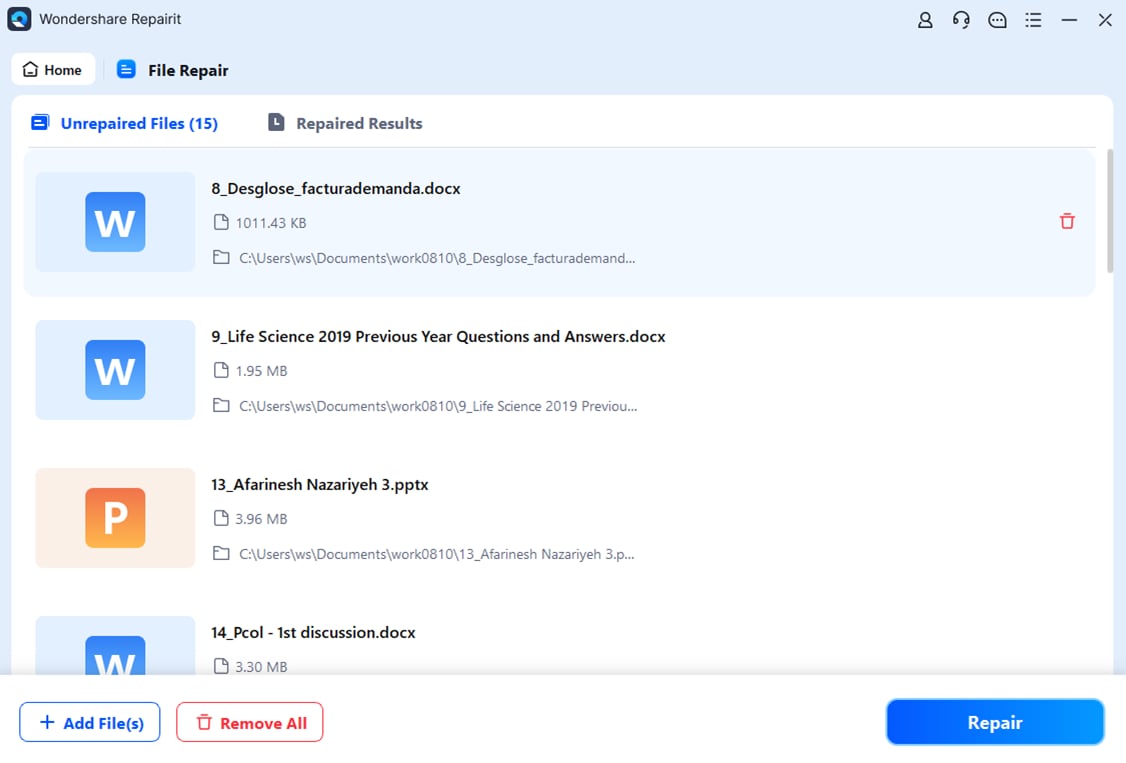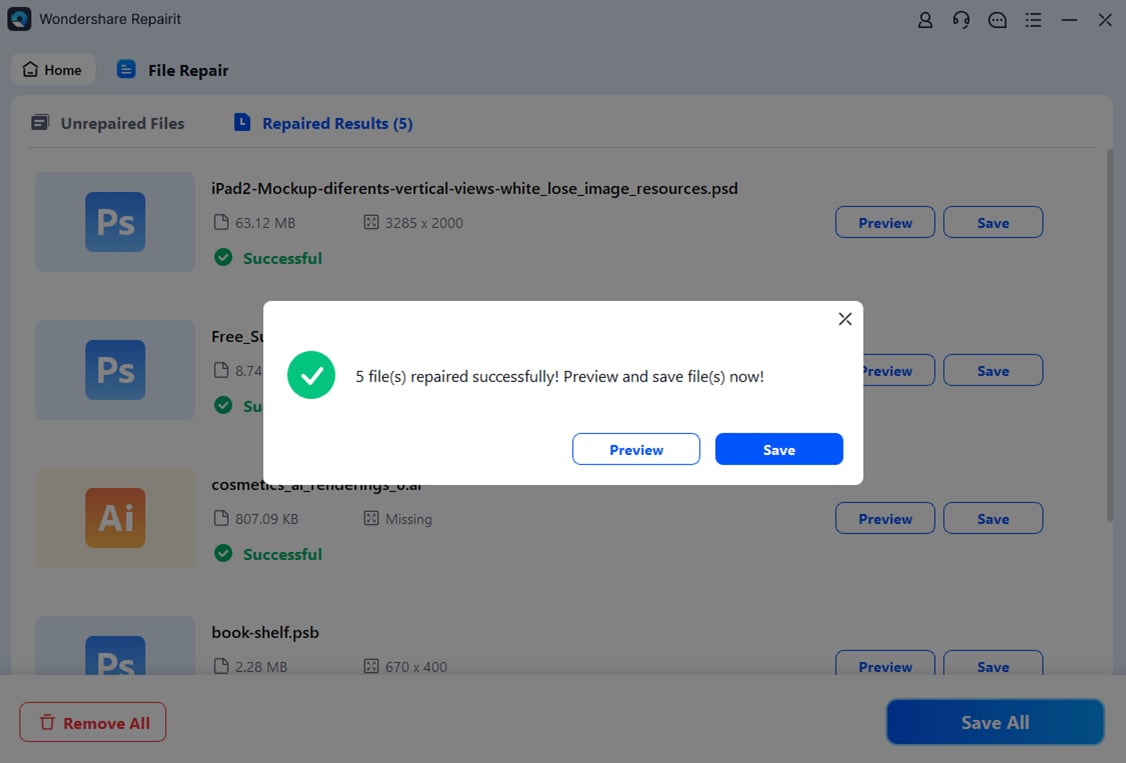"Why do my .csv files sometimes get messed up, where all the columns suddenly concatenate to the first two columns? Is it something with connecting to Tableau or is there another problem?"
CSV files are widely used for managing data, but sometimes, issues arise that result in corrupted files. If you're struggling with CSV files that won't open properly or are missing data, let us help you. This guide will guide you through several methods to repair CSV files to make sure that you can retrieve CSV files. It's not a problem if there is a formatting error or file corruption, the solutions below can help restore your CSV files.
In this article
Part 1. Why Your CSV File Gets Corrupted?
CSV, known as Comma-Separated Values, is a file format used to store data in a simple text form. Each line in a CSV file represents a row in a table, and commas separate the data in each row. CSV files are used in spreadsheets, databases, and data analysis tools because they are lightweight and can easily be opened in Microsoft Excel and Google Sheets.
However, despite its simplicity, CSV files can sometimes get corrupted. Here are some of the most common reasons why a CSV file might become corrupted:
📝Incorrect Formatting. CSV files rely on proper formatting, where a comma separates each data point. If extra commas, quotation marks, or line breaks are added incorrectly, the file may become unreadable. This often happens when the file is edited manually or opened in incompatible programs.
📂Large File Size. Very large files can sometimes become unstable and prone to corruption. This is particularly common when handling large datasets with thousands of rows and columns.
🌐File Transfer Issues. During file transfers, such as when downloading or sharing a CSV file, incomplete transfers can cause file corruption. For example, a dropped internet connection or an incomplete upload can lead to a damaged file.
⚡ Unexpected Shutdowns or Power Outages. If your system shuts down unexpectedly while the CSV file is open or being saved, it can result in data loss or file corruption. This often occurs during power outages or sudden system crashes.
🐞Software Bugs. The software used to create or edit the CSV file may contain bugs or glitches that cause errors when saving the file. Programs like Excel or data-processing tools can write the file incorrectly.
🔄Incorrect File Extensions. Saving a file with the wrong extension or renaming a file incorrectly can cause it to become corrupted. For example, renaming an Excel file with complex formulas and data as a .csv file may lead to data loss and improper formatting.
Part 2. How to Automatically Repair Corrupted CSV Files?
When you accidentally find out that you are facing a CSV file corruption, fixing it manually can be time-consuming and requires knowledge. The reason for this is that CSV file corruption might be worse if you lack technical knowledge on how to solve CSV issues.
Fortunately, tools like Repairit CSV File Repair offer an easy way to automatically fix CSV files. This software can restore damaged files without losing important information. Repairit scans and automatically identifies problems in the CSV structure and fixes errors without altering the original content.
Key features:

-
Supports all Excel formats: XLSX, XLSM, XLTX, XLTM, and XLS.
-
Repair Excel files with any level of damage, including issues like blank files, files that won't open, unrecognizable formats, unreadable content, or layout changes.
-
Restore all types of data in damaged Excel files, such as tables, charts, formulas, comments, and images.
-
Accurately repair corrupted files with a high success rate without changing the original file.
-
No limit on the number or size of files that can be repaired.
-
Support Windows 11/10/8/7/Vista, Windows Server 2003/2008/2012/2016/2019/2022, and macOS 10.12~macOS 15.
Step 1: Go to the "File Repair." Press "+Add" to upload your damaged CSV files. You can upload multiple corrupt CSV files at once with Repairit.

Step 2: To get the repair procedure started, click "Repair". You can view the way that Repairit fixes your corrupted CSV files.

Step 3: Click "Preview" next to the icon of any file to see the results. If it's fine, click "Save" to store the repaired CSV file on your Windows PC.

Automatically Repair Corrupted CSV Files

Part 3. How to Fix CSV Files Manually?
Sometimes, you may want to fix corrupted CSV files manually without using any software. While this can be more time-consuming, it's possible to resolve certain issues yourself, especially if the file corruption is minor. In this section, we'll go through some simple methods you can try to restore your CSV files manually.
Fix# 1. Employ "Text to Columns" to Divide Cells
If your CSV file has merged data or cells that aren't properly separated, you can use the Text to Columns feature in Excel to fix it. This method helps split data into individual columns, making it easier to read and work with. Follow these simple steps to fix the formatting issue:
Step 1. Highlight the data you want to fix and go to the Data tab.
Step 2. In the Data Tools group, select Text to Columns.

Step 3. Select Delimited from the Convert Text to Column Wizard and press Next.

Step 4. Select a Comma as the delimiter and click Next.

Step 5. Set the destination for the separated data and click Finish.

Fix# 2. Change the Delimiter in CSV File
If your CSV file isn't displaying correctly in Excel, changing the delimiter could help fix the issue. CSV files use characters like commas or semicolons to separate data, and sometimes, the wrong delimiter can cause formatting problems. Here's how you can fix it by manually adjusting the delimiter:
Step 1. Open your CSV file in any text editor (e.g., Notepad).

Step 2. Check if commas separate the data (,) or semicolons (;). For example, your data might look like this: Name, Age, Country.

Step 3. Add the following line at the very top of the file:
For commas: sep=,
For semicolons: sep=;

Step 4. Save the file and open it in Excel again, and your data should now display correctly in table format.

Fix# 3. Specifications for the Delimiter for Importing CSV Files into Excel
When importing a CSV file into Excel, choosing the correct delimiter is key to making sure the data is formatted correctly. Excel allows you to specify the delimiter that separates data points, whether it's a comma, semicolon, or another character. Here's how to import a CSV file and set the correct delimiter:
Step 1. Open Excel and go to the Data tab.
Step 2. In the Get & Transform Data group, click From Text/CSV.

Step 3. In the Import Data dialog box, select your CSV file and click Import.

Step 4. A preview of the file will appear. In the preview window, choose the correct delimiter (e.g., comma, semicolon) by observing how the data looks in the preview.
Step 5. After selecting the correct delimiter, click Load.

The data from the CSV file will be displayed in a new sheet as a table linked to the original document, meaning it will update whenever the CSV file is updated.
Alternatively, if you're using an older version of Excel, you can use the Text Import Wizard:
Step 1. In the Data tab, click on Get Data, then choose Legacy Wizards and select From Text.

Step 2. In the Import Text File window, select your CSV file and click Import.
Step 3. In the first step, check the Delimited option, and if your data has headers, select My data has headers.
Step 4. Click Next, then choose the correct delimiter (e.g., comma).

Step 5. Hit Next and choose the General column data format, then click Finish.

Step 6. Choose where you want the data to appear and click OK. Your CSV data should now be imported correctly.

Fix# 4. Using Unicode UTF-8 Encoding
Using the correct encoding is essential when dealing with special characters in CSV files. By saving the file in Unicode (UTF-8) format, you ensure that all characters are correctly recognized, especially when sharing the file across different platforms. Here鈥檚 how you can save your CSV file using UTF-8 encoding:
Step 1. Open your CSV file and click on File.
Step 2. Choose Save As and type in the desired Image name.
Step 3. From the drop-down menu, select CSV as the file type.
Step 4. Select Web Options by clicking on Tools.
Step 5. In the Web Options dialog box, navigate to the Encoding tab.
Step 6. Under Save this document, select Unicode (UTF-8).
Step 7. Click OK to save your file with the correct encoding.

Part 4. Tips to Prevent CSV File Corruption
Preventing CSV file corruption is important to avoid data loss. Here are some useful tips to help you maintain the integrity of your CSV files:
Tip 1. Ensure Proper Formatting
Always double-check that your CSV file follows the correct formatting rules. Check the commas or the appropriate delimiter to separate data points. Avoid adding extra spaces, line breaks, or special characters that may lead to file corruption.
Tip 2. Use Reliable Software
When working with CSV files, make sure to use trusted software like Excel or Google Sheets to edit and manage them. Some third-party tools might not handle large datasets or special formatting properly.
Tip 3. Avoid Large File Sizes
Split your data into smaller CSV files if it gets too large. Handling massive files can make them prone to corruption or instability during processing or saving.
Tip 4. Always Backup Your Files
Regularly back up your CSV files before making any changes. This way, you have a fallback in case something goes wrong, such as a file becoming corrupt due to accidental editing or system crashes.
Tip 5. Verify File Transfers
Ensure that file transfers are completed without interruptions. A dropped connection or incomplete transfer can damage your CSV file.
Tip 6. Be Cautious of Manual Edits
Editing CSV files in plain text editors like Notepad should be done with caution, as incorrect changes can easily corrupt the file. Use tools that offer formatting guidance when editing.
Conclusion
CSV files are essential for handling large data sets, but they can sometimes face issues. To fix CSV files, remember to follow the solutions we have prepared above. Also, to avoid corruption in the future, consider the best practices. For the final say, keep working with your data confidently, knowing you have the solutions to fix any CSV problems!
FAQ
-
FAQ: Can I fix a CSV file without using any software?
Yes, you can fix minor CSV file issues manually by adjusting delimiters or using Excel's Text to Columns feature. -
FAQ: Why is my CSV file displaying incorrectly in Excel?
This often happens due to incorrect delimiters. Make sure the separator in your CSV file matches the one Excel expects (comma or semicolon). -
FAQ: How can I prevent CSV file corruption?
To prevent corruption, ensure proper formatting, use reliable software, and always back up your files before making changes.


 ChatGPT
ChatGPT
 Perplexity
Perplexity
 Google AI Mode
Google AI Mode
 Grok
Grok

